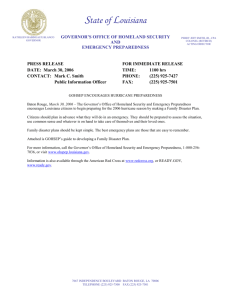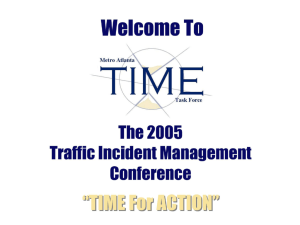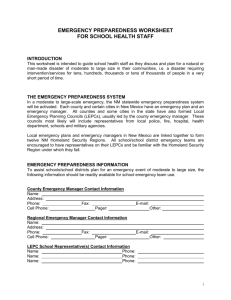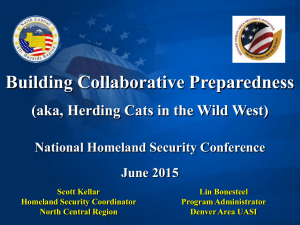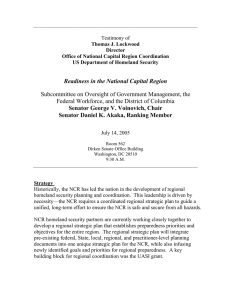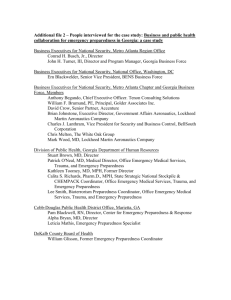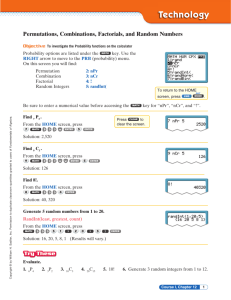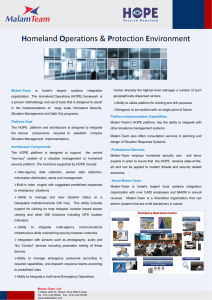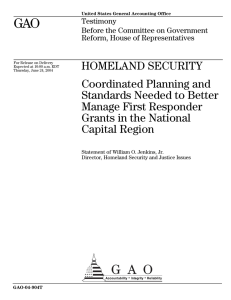Project Management Plan - Metropolitan Washington Council of
advertisement
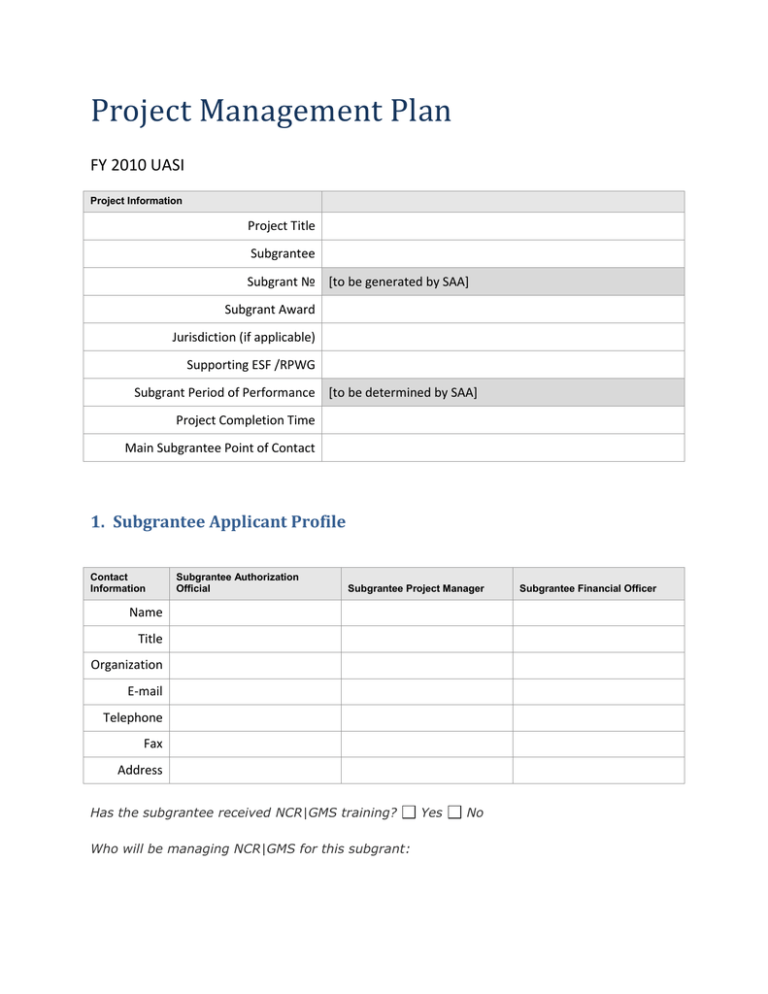
Project Management Plan FY 2010 UASI Project Information Project Title Subgrantee Subgrant № [to be generated by SAA] Subgrant Award Jurisdiction (if applicable) Supporting ESF /RPWG Subgrant Period of Performance [to be determined by SAA] Project Completion Time Main Subgrantee Point of Contact 1. Subgrantee Applicant Profile Contact Information Subgrantee Authorization Official Subgrantee Project Manager Name Title Organization E-mail Telephone Fax Address Has the subgrantee received NCR|GMS training? Who will be managing NCR|GMS for this subgrant: Yes No Subgrantee Financial Officer 2. Project Summary Summarize your project in a few sentences for each category: 2.1.Summary/Description of Project 800 character limit. 2.2.Current Capabilities Describe current capabilities and how this project will improve them. 800 character limit. 2.3.Continuation/Maintenance Project? Was the project previously funded? Subgrant ID Award Description 2.4.Risk and Approach 500 character limit per category. Risk Identify the homeland security-related risk that pertains to this project Approach How will your effort reduce this risk? 3. Deliverables and Tasks # 1 2 3 4 5 Deliverable # 1.1 1.2 1.3 1.4 1.5 2.1 2.2 2.3 2.4 2.5 3.1 3.2 3.3 3.4 3.5 4.1 4.2 4.3 4.4 4.5 5.1 5.2 5.3 5.4 5.5 Task Length of Time End Date 4. Spend Plan 4.1.Financial Plan AEL: Authorized Equipment List – this information will be used to enter the spend plan in NCR|GMS. Comptroller Object: To Be Filled by DC Agencies Only – this information will be used to load the budget. POETE: Planning, Organization, Equipment, Training, Exercises AEL Comptroller Object POETE Deliverable/ Task # Item Unit Cost Units 0 0 0 0 0 0 0 0 0 0 0 0 Grand Total Estimated Cost $ $ $ $ $ $ $ $ $ $ $ $ 0.00 0.00 0.00 0.00 0.00 0.00 0.00 0.00 0.00 0.00 0.00 0.00 $ 0.00 4.2.Sustainment Maintenance Category Answer Long-term Sustainment Plan. 1. No future costs are anticipated. Will Homeland Security Grant funds be required for sustainment? 2. Subgrantee will assume all future costs. (Choose one of the following) 3. Subgrantee will need future grant funding to cover all costs. 4. Subgrantee will assume part of the costs and need future grant funding to cover the rest. Maintenance Budget Annual budget: Years of maintenance required: Useful Life. How long will the equipment be useful? 6. Additional Information Likelihood (H, M, L) Time Budget Risk Title Quality 5. Risk Plan Mitigation Steps years 7. Project Details 7.1.National Preparedness Guidelines National Priority – Select one Implement the National Incident Management System and National Response Plan Expanded Regional Collaboration Implement the Interim National Infrastructure Protection Plan Strengthen Information Sharing and Collaboration Capabilities Strengthen Interoperable Communications Capabilities Strengthen Chemical, Biological, Radiological, Nuclear, and Explosive Detection, Response and Decontamination Capabilities Strengthen Medical Surge and Mass Prophylaxis Capabilities Target Capability(ies) – Select up to three Common Capabilities Planning Communications Community Preparedness and Participation Risk Management Intelligence and Information Sharing and Dissemination Prevent Mission Capabilities Information Gathering and Recognition of Indicators and Warning Intelligence Analysis and Production Counter-Terror Investigation and Law Enforcement CBRNE Detection Protect Mission Capabilities Critical Infrastructure Protection Food and Agriculture Safety and Defense Epidemiological Surveillance and Investigation Laboratory Testing Respond Mission Capabilities On-Site Incident Management Emergency Operations Center Management Critical Resource Logistics and Distribution Volunteer Management and Donations Responder Safety and Health Emergency Public Safety and Security Animal Disease Emergency Support Environmental Health Explosive Device Response Operations Fire Incident Response Support WMD and Hazardous Materials Response and Decontamination Citizen Evacuation and Shelter-in-Place Isolation and Quarantine Search and Rescue (Land-Based) Emergency Public Information and Warning Emergency Triage and Pre-Hospital Treatment Medical Surge Medical Supplies Management and Distribution Mass Prophylaxis Mass Care (Sheltering, Feeding and Related Services) Fatality Management Recover Mission Capabilities Structural Damage Assessment Restoration of Lifelines Economic and Community Recovery DHS Project Type – Select one Establish/enhance a terrorism intelligence/ early warning system, center, or task force Establish/enhance a agro-terrorism preparedness capabilities Establish/enhance cyber security program Establish/enhance emergency operations Establish/enhance public-private emergency preparedness program Establish/enhance sustainable homeland security exercise program Manage, update and/or implement the State Homeland Security Strategy center Establish/enhance regional response teams Establish/enhance sustainable homeland security training program Administer and manage the FY07 Homeland Security Grant Establish/enhance sustainable Homeland Security Planning Program Establish/enhance citizen awareness of emergency preparedness, prevention and response measures Establish/enhance citizen / volunteer initiatives Adopt and implement NIMS to include integration of core concepts into plans and procedures Assess vulnerability of and/or harden/protect critical infrastructure and key assets Build/enhance a pharmaceutical stockpile and/or distribution network Develop/enhance interoperable communications system Enhance capability to support international border and waterway security Establish/enhance a public health surveillance system Establish/enhance Citizen Corps Councils Establish/enhance explosive ordnance disposal units/bomb squads Manage, update and/or implement the Urban Area Homeland Security Strategy Develop/enhance plans, procedures, and protocols Develop/enhance homeland security / emergency management organization and structure Enhance integration of metropolitan area public health / medical and emergency management capabilities Establish/enhance mass care shelter and alternative medical facilities operations Establish/enhance emergency plans and procedures to reflect the National Response Plan Develop/enhance state and local geospatial data system/Geographic Information System (GIS) Enhance capabilities to recover from all-hazards events Enhance capabilities to respond to all-hazards events Enhance capability to perform post-incident structural damage and mitigation assessment Enhance capability to restore lifelines post incident Enhance capability to support economic and community recovery Establish/enhance fusion center Manage, update and/or implement the Regional Transit Security Strategy Transit Security Grant Program – BUS Transit Security Grant Program – FERRY Transit Security Grant Program – RAIL 7.2.Homeland Security Strategy (only applicable for UASI projects) Strategic Initiative(s) – Select up to three 1 PLANNING & DECISION-MAKING 1.1 Strengthen the regional approach to homeland security planning and decision-making. 1.1.1 Develop and periodically update the Strategic Plan and related processes. 1.1.2 1.2 Document and implement the components and sequence of the NCR HLS regional planning process, incorporating results of lessons learned. Establish an NCR-wide process to identify and close gaps using public and private resources. 1.2.1 1.3 Design and conduct a risk-based threat analysis to identify and address gaps in regional preparedness. 1.2.2 Establish a requirements generation and prioritization process that addresses needs of all practitioners. Enhance oversight of and accountability for the management of investments and capabilities. 1.3.1 1.3.2 2 Establish regional oversight and accountability function with appropriate tools and resources for performance transparency. Develop investment lifecycle planning approach to ensure infrastructure and resources are available to support multi-year operational capabilities. COMMUNITY ENGAGEMENT 2.1 2.2 Increase public preparedness through education campaigns and emergency messaging before, during and after emergencies. 2.1.1 Establish regional protocols and systems for developing and distributing emergency information to all NCR populations. 2.1.2 Develop and sustain multiyear education campaigns to provide all the public (residents, workers and visitors) with preparedness information. Strengthen the partnerships and communications among the NCR’s public, civic, private, and NGO stakeholders. 2.2.1 Identify and develop opportunities and resources for stakeholder partnerships to broaden participation in public disaster preparedness. 2.2.2 Increase civic involvement and volunteerism in all phases of disaster preparedness. 3 PREVENTION & PROTECTION 3.1 Develop and maintain common regional standards for planning, equipping, training, operating and exercising. 3.1.1 Develop a prevention and mitigation framework for the region. 3.1.2 3.1.3 3.1.4 3.2 3.3 Develop a synchronized and integrated training and exercise framework, with appropriate common standards. Develop an integrated plan related to health surveillance, detection and mitigation functions between NCR Partners. Develop a community-wide campaign, focused primarily on prevention and deterrence. Strengthen the exchange and analysis of information across disciplines for improved situational awareness. 3.2.1 Develop common regional information sharing and collaboration frameworks, to include determining roles, responsibilities and protocols. 3.2.2 Ensure that each jurisdiction has appropriate people cleared to receive, analyze, and act on sensitive and classified information. Employ a performance- and risk-based approach to critical infrastructure protection across the NCR. 3.3.1 3.3.2 Conduct a prioritization of recommended high priority CIP protective and resiliency actions based on security assessment findings already completed and shared with the NCR. Create an inventory of CI of assets and work on developing a common methodology for assessing the risk to CI across all relevant sectors within the NCR and recommend initial protective and resiliency actions. 4 RESPONSE & RECOVERY 4.1 Develop and implement integrated response and recovery plans, policies, and standards. 4.1.1 4.1.2 4.1.3 4.2 Establish a corrective action program to modify plans by addressing gaps identified in analyses, exercises & events. Align and integrate response plans across jurisdictions (including Federal partners), with emphasis on continuity of government, operations, and evacuation. Define capabilities and expectations for decontamination and re-entry. Strengthen all components of an integrated region wide response and recovery capability. 4.2.1 4.3 Develop coordinated and standardized protocols for mandatory notification of regional partners during an emerging incident to maintain situational awareness. 4.2.2 Develop and implement a plan for regionally coordinated adoption and employment of National Incident Management System (NIMS). 4.2.3 Develop and implement enhanced architecture, infrastructure, and concept of operations for secure regional interoperable communications Improve and expand effective resource sharing systems and standards. 4.3.1 Develop a regional resource management system for deployment and utilization of resources. 4.4 4.3.2 Establish and implement regional, interdisciplinary protocols (e.g. Mutual Aid agreements). 4.3.3 Establish and implement regional, interdisciplinary standards for equipment interoperability. Identify and close gaps in long-term recovery capabilities. 4.4.1 Model and exercise the appropriate 15 DHS scenarios to assess region-wide impact. 4.4.2 Align public, private and NGO resources with identified needs for response and recovery. 4.4.3 Review existing programs, mutual aid agreements, MOUs, and legislation to identify and close gaps in facilitating long-term recovery.
